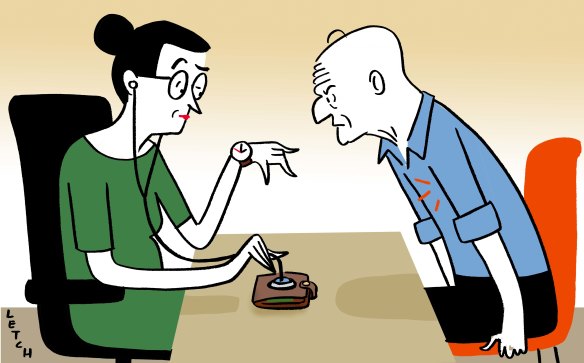This was published 3 months ago
Opinion
Why this unhealthy trend may become an ill wind for Medicare
Matt Wade
Senior economics writerDuring 25 years reporting about economics I’ve learnt one indicator tells you more than any other about a nation’s welfare: longevity. Show me a nation where citizens can expect to live long, healthy lives, and I’ll show you a place that is getting plenty of things right.
The good news is that Australia excels when it comes to life spans. An international league table published recently by the Bureau of Statistics ranked Australia third in the world for life expectancy at 84.53 years just behind Japan (84.78) and Monaco (85.95). Aussie blokes do even better, coming in at No.2 in the world for life expectancy. Australian women have longer life expectancy than men but were ranked sixth.

Illustration by Simon LetchCredit:
The longevity that Australians enjoy has been underpinned by a precious national asset: our health system. Last month, the internationally renowned US think tank, the Commonwealth Foundation, compared 10 of the world’s leading national health systems and rated Australia No.1.
What’s more, that top ranking was achieved even though the share of GDP Australia spends on healthcare, around 10 per cent, was lower than every other nation in the study. The US, for instance, allocates over 16 per cent of GDP to healthcare but had far worse outcomes. Life expectancy in America is just over 77 years.
A Productivity Commission study published earlier this year concluded our health system “delivers some of the best value for money of any in the world”. Even so, there are many signs that system is under growing pressure.
A few months ago a sign went up in my doctor’s surgery announcing the cost of a standard weekday consultation was rising from $85 to $90; that leaves me $47.15 out of pocket when I see a GP after receiving the Medicare rebate.

Australia’s health system has underpinned decades of rising life expectancyCredit: Getty Images
It’s the same for millions of Australians - a survey by health directory website Cleanbill this year found the average cost for non-concession patient GP visits had reached $41.69. In parts of Melbourne that average was well over $50 and in Sydney’s Woollahra Council area it was just under $70. And of course, the out-of-pocket cost to see a private specialist is often far higher.
Having to fork out more than $40 to see a GP is a major impost for many families under pressure due to the lingering cost-of-living crunch. A survey by the Bureau of Statistics found 7 per cent of Australians said cost was a “reason for delaying or not using” a GP in 2022-23, up from 3.5 per cent the year before. That proportion climbed to 10 per cent among those aged between 25 and 34.
A Medicare rebate freeze between 2013 and 2018 is one reason out-of-pocket costs have become more noticeable. Like all businesses, GP practices have also been hit by the spike in inflation since early 2022.
Elizabeth Deveny from the Consumers Health Forum says many families are making trade-offs to cover health costs.
“I hear from people all the time about the struggles they’re having affording their health care,” she says. “It’s common for people to say things like ‘my kids needed to go to the doctor, so I didn’t’.”
Many of those who put off going to the GP or specialist will inevitably end up in public hospitals. For some, their health problems will have become more serious, and more costly to treat.
It’s not all bad news. The overall rate of GP bulk-billing has improved this year after federal Labor introduced higher bulk-billing incentives for GPs. That has made it easier for those with children aged under 16, pensioners and other concession cardholders to find a bulk-billing doctor. Together, those patients make up around three in five visits to a GP.
Pharmacists are also being allowed to do more – the NSW government recently broadened the conditions they can treat in local chemist shops, including ear infections, stomach bugs and joint pain. But the growth in out-of-pocket costs to see a GP is a tangible sign that our world-beating health system is strained.
Over the past few decades, improvements in health – such as longer life expectancy – have been supported by strong and persistent growth in the Australian economy, advances in medical treatments and favourable demographics.
But the Grattan Institute’s Peter Breadon warns that health “sweet spot” might be coming to an end, especially as the share of older people grows.
“More chronic diseases and big risk factors like obesity are already starting to come through, but they’re likely to get worse and worse,” he says. “We could see some of those advantages we once had slip away.”
Australia’s illness-prevention policies lag many comparable countries.
“Most countries in the world have a tax on sugary drinks, but we don’t,” says Breadon. “Many countries have restrictions on junk food advertising to children and requirements for front-of-pack food labelling, but we don’t have those things. We spend much less on prevention than most rich countries. So in some ways we’ve become complacent.”
Health consumers and medicos must adapt to meet increasingly complex health challenges as Australia’s population ages and chronic diseases become more prevalent.
Keeping Australia’s health system at the top of the world rankings is about to get harder.
Matt Wade is a senior economics writer at The Sydney Morning Herald.